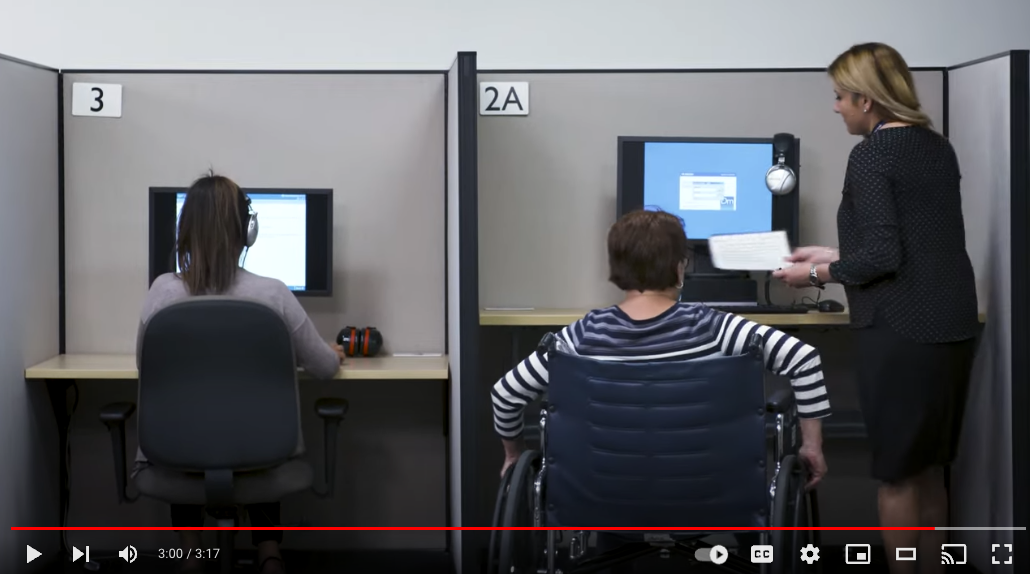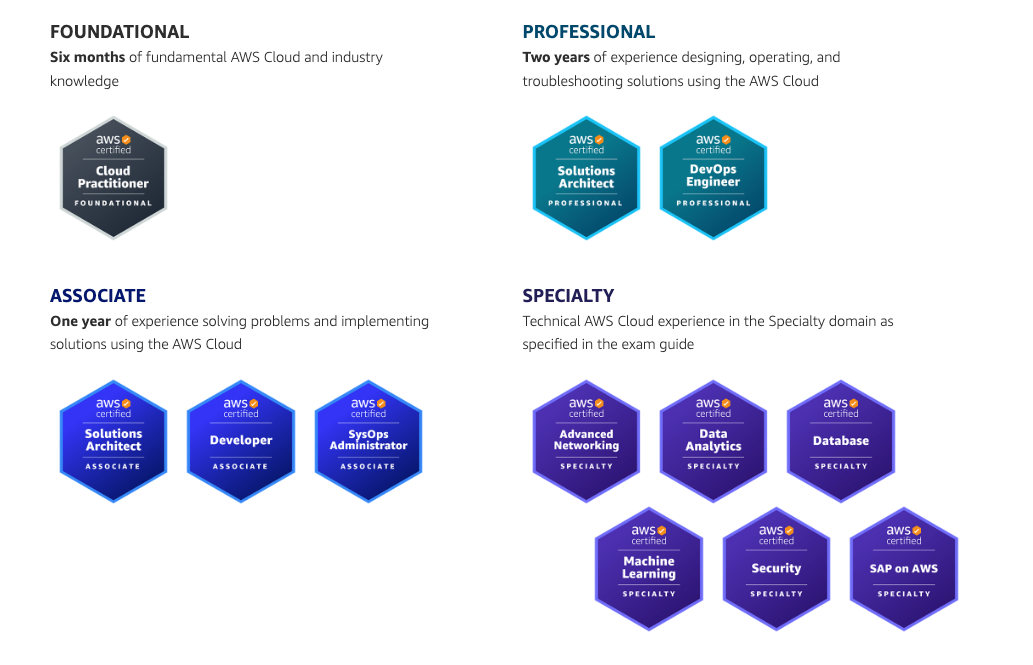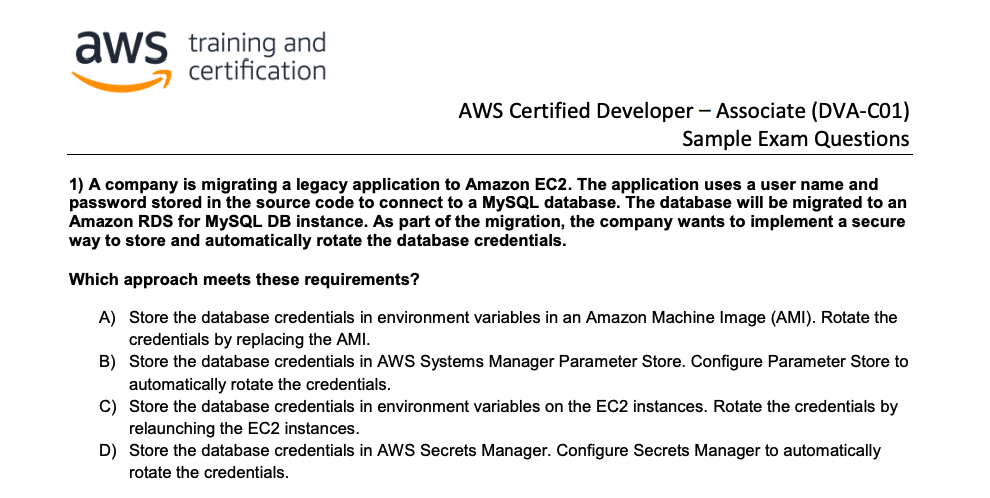AWS Certified Developer

I passed the AWS Certified Developer - Associate certification exam a week ago. Below I’m sharing my journey, thoughts, and tips about the process.
Why I decided to pass the certification exam?
In broad strokes, I had two primary goals: the certificate and the knowledge that the preparation brings.
Knowledge part. I worked with AWS for many years and felt I understood the ecosystem well enough. Still, I always had a feeling that my knowledge was quite chaotic and, likely, incomplete. I wanted to have a more systematic approach to learning about the platform.
You don’t know what you don’t know. With ad-hoc, non-systematic knowledge, you don’t know if you have any gaps. As a result, there’s not enough confidence that your solution is optimal.
Assess yourself against a benchmark. Not a bad thing at all. With a benchmark, you can set the baseline or your knowledge. Helpful to beat impostor syndrome.
Certificate. For future clients and partners, the certificate brings confidence that an independent external party checked my knowledge and confirmed that I am not foreign to the AWS Stack.
Aren’t certifications just vanity badges?
It depends on your expectations and on the certification process itself. I think none of the mass certification programs in IT can guarantee deep domain expertise. Still, if you consider a certificate as proof that the certified person is no stranger to the domain area, that would be fair.
AWS has many certifications. How did I choose mine?
When I started my preparation, I knew nearly nothing about different certification programs, so I began from the Available AWS Certifications list. My goal was to become a better developer and learn how to write cloud-native applications, so it felt natural to choose the “Developer” track.
Following the link and clicking a badge opens the certification details that include, among others, the exam guide listing areas and skills necessary to pass the exam and sample questions.
A few more things on choosing the right certification:
- The Solution Architect is the most popular exam people take from the “Associate” bucket.
- Some people choose to pass two or three exams, one after another, as the domain area significantly overlaps, and if you prepared for one example, you’re, like, 60% prepared for others.
What does the certification look like?
You must answer 65 single- or multiple-choice questions to pass the exam. None of the exams includes the hands-on part.
The time limit is quite generous: 2 hours 15 minutes. As for me, I never felt time pressure answering the questions. It usually took me about an hour to pass them all when I did my dry runs. On the exam, I spent almost two hours answering questions.
- More details are available in their Exam guide.
- Also, look at AWS Certified Developer sample questions with detailed answers.
How is the process organized?
You can pass the certification online or in one of the certification centers.
Amazon doesn’t organize certification itself. Instead, they partner with two certifiers, where Pearson VUE is the biggest by the number of certifying centers.
Online tests. At first, I was thinking of passing the test online. Then I dug deeper and learned that to pass the test online, you need to install spyware on your computer, and a proctor will monitor you throughout your exam via the webcam and microphone. You also need to show the proctor your room so that they can certify you don’t have any learning materials. Here’s how it looks like.
Certification center. I was not ready to invite a stranger to my house and computer, so I decided to explore the second option. To my surprise, on-site certification was an easy treat for me. In the Porto area, there are four certification centers, and there are many options to pass the exam several times a week and choose from the most convenient timeslot.
Overall, the test exam experience matches the one presented on the Pearson VUE website. You come into a class, leave all your belongings outside in a deposit box, and spend two hours answering the questions.

What to expect when testing with Pearson VUE
You don’t get the results immediately. They send you the results within five working days by email, but I get my confirmation the next day.
Exam preparatory mindset
Here are a few things that helped me pass the exam.
Laser focus. Everything that is out of the scope of the exam has to be a lower priority. To become a better AWS developer, you need to know more than the AWS exam asks, but first, you need to focus on exam preparation. Making practice exams helped me to focus — they provide an overview at a glance of where your actual certification-relevant knowledge is.
Set the deadline. Setting an artificial deadline helped me to set priorities straight and overcome that “I’m not prepared enough” feeling. If necessary, find an accountability partner, someone who can help you stick to your commitments.
Breath over depth. The certification includes questions for 32 AWS services, and there’s no way you can learn in-depth all of them.
In the beginning, one of my mistakes was diving deep into each topic. My progress was too slow to hit the deadline in time. I had to block myself from diving into topics I’m excited about to spend enough time on less exciting topics.
Regularity is the key. Put aside 15-30 minutes per day to learn new concepts. I had a recurring daily Todoist task for a reminder. Time blocking can help too.
Be prepared to fail. Loss aversion can paralyze you with the “I’m not prepared enough” feeling and put you in an endless loop of rehearsals. To be more rational, I asked myself, “how many hours of my work an exam costs.” Ask the same question yourself. It will likely be much fewer hours than you would otherwise spend overlearning.
Unnecessary services
Not all 32 Amazon services included in the exam are equally valuable in real world.
On top of great stuff, like API gateways, Lambda, or SQS queues, that likely become the skeleton of your applications, you need to learn about services that almost nobody uses.
For example, Amazon Cognito is notoriously hard to configure and has awful developer experience. Similarly, choosing AWS CodeCommit to host a git repository doesn’t make much sense in a world with GitHub and GitLab.
This way or another, you need to learn about them all. Also, you need to play by the rules and choose “Cognito Identity pools “as the “easiest option to implement authentication with third-party identity providers,” even if you’re screaming inside.
Practice exams
You can start passing practice exams (the ones that mimic the real exam questions) from day one. In fact, I regret that I haven’t started with them earlier. Where to get them?
- Each certification provides an official practice question set on its exam page. It’s a good starting point, but it has only 20 questions.
- I took five exam attempts in A Cloud Guru. They are available for the “Personal Basic” plan.
- An alternative I considered was DigitalCloud training courses for about the same price.
Udemy course
The Udemy course AWS Certified Developer Associate 2022 from Stephane Maarek is a gem: well-organized, the right mixture of theory and hands-on exercises, laser focus on the exam topic.
I came across this course a few days before the exam and watched as many videos as possible, literally, until the moment I entered the exam room.
After passing the exam, I kept watching the tutorials, which I found valuable outside the certification context. There’s plenty of content!
Was it worth it?
It definitely was! I’m not sure how valuable the badge is, but the knowledge it brings was well worth it.

